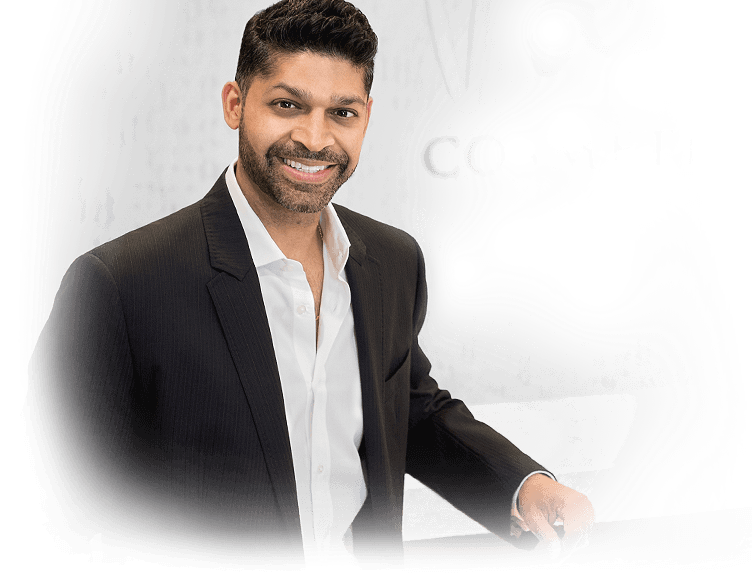Fat Transfer Las Vegas
Our bodies are genetically programmed to store excess fat in certain areas, but often these are not areas we’d have chosen. For example, you might have extra belly fat and a flat butt that makes it hard to find jeans that look good. Or, you might have stronger thighs and smaller breasts that cause your lower body to look disproportionately heavy. If you feel like your curves aren’t cooperating, Dr. Pancholi can help the fat work in your favor by using it as the ultimate sculpting tool.
- What is a fat transfer?
- How can a fat transfer enhance my body?
- How does a fat transfer work?
- What is the recovery time after a fat transfer?
- How can I learn more about fat transfer in Las Vegas?
What is a fat transfer?
The basic concept of a fat transfer is simple: excess fat is sculpted away from one or more areas using liposuction, and some of that fat is used to enhance areas that lack shape or volume, helping you achieve that naturally attractive shape that’s just waiting to be revealed. When performed by a highly experienced, skilled cosmetic surgeon, a fat transfer can dramatically improve your proportions with minimal scarring and, if for your breasts, no implants. Because your own healthy fat tissue is used as a “filler,” results can last for many years.
Your cosmetic surgeon’s skill & artistry are the most important factors during a fat transfer
In practice, a fat transfer is anything but simple. Your results depend almost entirely on how well your cosmetic surgeon can envision what’s possible for your body and sculpt that optimal shape. Well-known in Las Vegas for his expertise in body sculpting using liposuction, Dr. Samir Pancholi uses his skill as an artist and surgeon to achieve just the right amount of projection and fullness to areas you’d like to enhance, and optimizing placement to ensure the transferred fat “takes” in its new location to provide you with results you love for years to come.
Read more about Dr. Pancholi’s training & credentials
How can a fat transfer enhance my body?
Dr. Pancholi can sculpt and enhance the body using fat transfer techniques to meet a variety of patient goals, including:
- Transform a flat butt to a beautiful, round derriere, framed by a slimmer waist and thighs
- Add fullness to the upper pole or sides of the breasts to achieve beautiful cleavage
- Fill indented scars to restore a smooth, even look to a feature
- Create a more distinct hourglass figure by sculpting the waist and adding fullness to the hips
- Bring the upper and lower body into better proportion by transferring fat from the hips and belly to the breasts, or from the breasts/upper back to the buttocks and hips
- Key Benefits
- Glossary
- Natural-Looking Results: Since it uses the patient’s own fat, the results often look and feel more natural compared to synthetic fillers or implants.
- Improved Volume and Contour: Fat transfer can add volume and improve contours in areas like the face (lips, cheeks, under-eye area), breasts, buttocks, and hands.
- Reduced Risk of Allergic Reactions: As the procedure uses the body’s own fat, there is a significantly reduced risk of allergic reactions compared to other materials.
- Dual Benefit of Liposuction: Fat is harvested through liposuction, providing the added benefit of reducing fat in unwanted areas.
- Long-Lasting Results: While some of the transferred fat may be reabsorbed, a significant portion typically remains, offering long-lasting results.
- Minimally Invasive: Compared to implant-based augmentation, fat transfer is less invasive, with smaller incisions and potentially lower risk of complications.
- Enhanced Texture and Skin Quality: In addition to adding volume, fat transfer can improve the texture and quality of the skin in the treated area.
- Reduced Scarring: Fat transfer requires only small incisions for fat extraction and injection, leading to minimal scarring.
- Adipose Tissue: Another term for fat tissue, which is harvested and transferred during the fat grafting process.
- Anesthesia: Medications used to prevent pain during surgery, which can be either general (inducing unconsciousness) or local (numbing a specific area).
- Autologous Fat Transfer: A procedure where fat is removed from one part of the patient’s body (usually through liposuction) and injected into another area to enhance volume and shape.
- Cannula: A thin tube used to extract and transfer fat during liposuction and fat grafting procedures.
- Donor Site: The area of the body from which fat is harvested for transfer, commonly the abdomen, thighs, or buttocks.
- Fat Cells: Cells in the body that store fat, targeted for removal and transfer in fat grafting procedures.
- Fat Grafting: The process of transferring fat from one part of the body to another, used in cosmetic and reconstructive surgeries for volume enhancement.
- Liposuction: A surgical technique used to remove fat from specific areas of the body, often the first step in a fat transfer procedure.
- Microfat Grafting: A technique in fat transfer where fat is injected in small amounts for more precise contouring.
- Nanofat Grafting: A refined form of fat grafting where fat cells are further processed to be smoother and finer, used for areas needing very detailed enhancement.
- Seroma: A collection of fluid that builds up under the skin, a potential complication of procedures like liposuction used in fat transfer.
- Survival Rate of Fat Cells: Refers to the percentage of transferred fat cells that successfully integrate and survive in their new location.
- Swelling: A common post-operative symptom that occurs as the body heals from surgical procedures like fat transfer.
- Tumescent Technique: A method used in liposuction where a medicated solution is injected into the fatty area before extraction to minimize bleeding and discomfort.
How does a fat transfer work?
Dr. Pancholi performs surgery exclusively in accredited operating facilities for your safety, comfort, and privacy. Anesthesia is provided by a board certified anesthesiology team.
The fat transfer procedure begins with liposuction. Dr. Pancholi will carefully remove excess fat from the areas that will benefit you most. This is step 1 of the sculpting process. Dr. Pancholi then places some of this fat to into areas where the best strategy is to enhance shape or volume. He has great control over this process from start to finish to achieve the beautiful shape you have the potential to reveal.
Abdominal liposuction before fat transfer
Dr. Pancholi explains his sculpting technique during the liposuction phase of a body fat transfer procedure. Warning: video contains graphic images of live surgery. Viewer discretion is advised.
This contains graphic images.
Click to verify you are at least 18 years of age to view this video.
Dr. Pancholi transfers fat to the buttocks
Dr. Pancholi adds fat strategically to reshape the buttocks and hips. Warning: video contains graphic images of live surgery. Viewer discretion is advised
This contains graphic images.
Click to verify you are at least 18 years of age to view this video.
View more of Dr. Pancholi’s fat transfer videos
How long is the recovery from a fat transfer?
Fat transfer recovery time and activity restrictions depend on the areas of the body treated as well as how much fat was removed and transferred. Keeping direct pressure off the area that received the fat is critical during the first 4 weeks of recovery. For example, if you are having a fat transfer to the buttocks, you must avoid sitting on your butt during this time, except to use the bathroom. Most patients take 1 to 2 weeks off of work, and modify their position until the 4-week mark.
Results are typically close to final within 6 months, after post-op swelling and bruising have dissipated and most of the transferred fat has “taken” in its new location and become a natural component of the area.
Area Served
Interested in learning more about fat transfer in Las Vegas?
The best way to find out if a fat transfer can help you get the attractive body contours you want is to meet with an experienced cosmetic surgeon. Contact us today to schedule your consultation with Dr. Pancholi at Cosmetic Surgery of Las Vegas.
References »
Nemir S, Hanson SE, Chu CK. Surgical Decision Making in Autologous Fat Grafting: An Evidence-Based Review of Techniques to Maximize Fat Survival. Aesthetic Surgery Journal. 2021 May 18;41(Suppl 1):S3-S15. doi: 10.1093/asj/sjab080.
Hanson SE. The Future of Fat Grafting. Aesthetic Surgery Journal. 2021 May 18;41(Suppl 1):S69-S74. doi: 10.1093/asj/sjab130.
Dayal A, Bhatia A, Hsu JT. Fat grafting in aesthetics. Clinics in Dermatology. 2022 Jan-Feb;40(1):35-44. doi: 10.1016/j.clindermatol.2021.08.010.
Tonnard P, Verpaele A, Carvas M. Fat Grafting for Facial Rejuvenation with Nanofat Grafts. Clinics in Plastic Surgery. 2020 Jan;47(1):53-62. doi: 10.1016/j.cps.2019.08.006.
Mehta-Ambalal SR. Neocollagenesis and Neoelastinogenesis: From the Laboratory to the Clinic. Journal of Cutaneous and Aesthetic Surgery. 2016 Jul-Sep;9(3):145-151. doi: 10.4103/0974-2077.191645.


